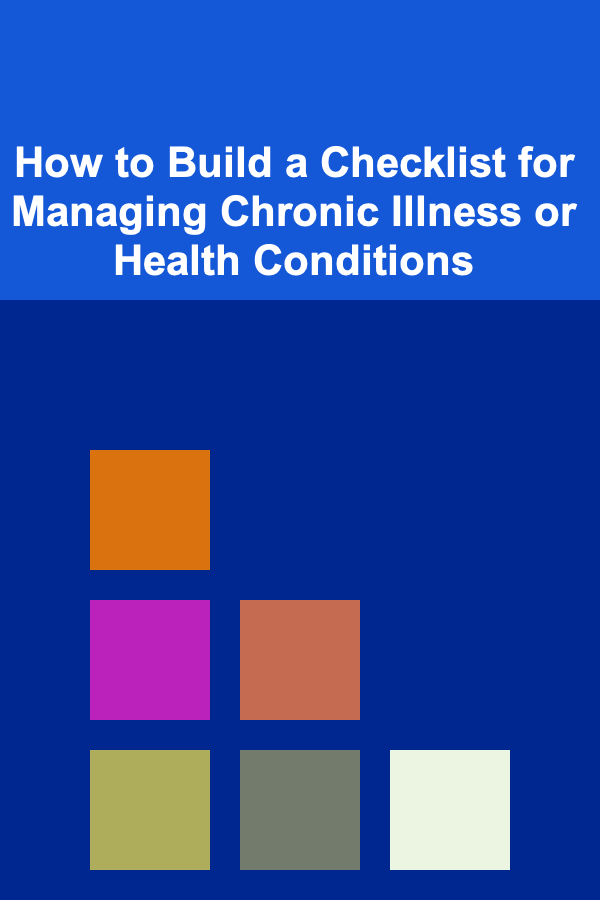
How to Build a Checklist for Managing Chronic Illness or Health Conditions
ebook include PDF & Audio bundle (Micro Guide)
$12.99$5.99
Limited Time Offer! Order within the next:

Living with a chronic illness or health condition can often feel like a constant balancing act. The daily tasks and routines that are necessary to manage symptoms, medications, and medical appointments can be overwhelming. However, having a structured approach, such as a checklist, can help you feel more in control and improve your quality of life. A well-designed checklist can simplify your daily routine, ensure you don't miss important tasks, and help you stay focused on your health goals.
In this actionable guide, we'll explore how to build an effective checklist for managing chronic illness or health conditions, break down the key areas of focus, and provide practical steps for creating one that works for you.
Why a Checklist is Essential for Managing Chronic Illness
A checklist serves as a powerful tool for managing chronic illness for several reasons:
- Organization: Keeping track of your symptoms, treatments, and daily tasks can be overwhelming without a clear system. A checklist helps you organize and prioritize your health-related activities.
- Consistency: Consistent management is crucial when dealing with chronic conditions. A checklist ensures that you don't forget important tasks, such as taking medication or monitoring your symptoms.
- Track Progress: Having a checklist allows you to monitor your symptoms, identify patterns, and keep track of progress over time. This information can be valuable when speaking with healthcare providers.
- Reduce Stress: By visually breaking down your tasks, a checklist can reduce the mental load and help you stay focused on one step at a time.
Step-by-Step Guide to Building Your Chronic Illness Management Checklist
To create an effective checklist, you first need to assess your individual needs, break down the major components of managing your condition, and set clear, actionable goals. Let's walk through this process step-by-step.
Step 1: Assess Your Chronic Condition
The first step in creating a checklist for managing your chronic illness or health condition is to thoroughly assess your situation. Understanding the nuances of your condition will help you tailor the checklist to meet your specific needs. Consider the following:
- Nature of the Condition: What is the chronic illness or health condition you're managing? Does it require regular medication, symptom monitoring, or lifestyle adjustments?
- Symptoms and Fluctuations: How do your symptoms fluctuate over time? Do they worsen during certain times of the day, week, or month?
- Treatment Plan: What are the treatments or interventions prescribed by your healthcare provider? These might include medications, physical therapy, lifestyle changes, or frequent doctor visits.
- Support Network: Do you have family, friends, or caregivers who assist you in managing your condition? Identify what tasks they may need to help with and how they can support you.
By understanding the specifics of your condition, you'll be better equipped to determine which tasks need to be included in your checklist.
Step 2: Identify Key Areas for Your Checklist
A comprehensive checklist should cover all aspects of your condition, from medical treatments to lifestyle adjustments. Here are the major areas that should be included in your chronic illness management checklist:
1. Medication Management
Medications are often a core part of managing chronic conditions. A checklist helps ensure that you take your medications on time and as prescribed.
- Daily Medications: List any medications you need to take on a daily basis, including dosage and time of day.
- Refills: Track when you need to refill prescriptions, ensuring you don't run out of medication.
- Side Effects: Keep an eye on any potential side effects and monitor how they affect you, noting any changes or concerns.
- Doctor's Orders: If your healthcare provider adjusts your medication, update the checklist to reflect these changes.
2. Symptom Tracking and Monitoring
Tracking your symptoms is essential for understanding how your condition is progressing and identifying triggers that may worsen your health. This can also be valuable information for your healthcare provider.
- Daily Symptoms: List the symptoms you experience each day. Track their severity, duration, and any patterns you notice.
- Changes in Symptoms: Pay attention to any changes in your condition---whether things are improving, worsening, or staying the same.
- Triggers: Identify common triggers that worsen your symptoms, such as stress, weather changes, food, or activity level.
3. Physical Activity and Exercise
Exercise can play a critical role in managing chronic conditions, especially for conditions like arthritis, diabetes, and heart disease. Your checklist should include:
- Daily Movement: Track the amount of physical activity you're getting each day, even if it's just light walking or stretching.
- Exercise Plan: Include a specific exercise plan recommended by your healthcare provider, such as strength training, yoga, or cardiovascular exercise.
- Rest Days: Ensure you're incorporating adequate rest into your schedule to prevent burnout or overexertion.
4. Nutrition and Hydration
Nutrition is often a cornerstone of managing chronic health conditions. Your checklist should include:
- Dietary Guidelines: List any dietary restrictions or recommendations from your healthcare provider, such as limiting sodium, sugar, or processed foods.
- Meal Planning: Create a meal plan that supports your health goals, making it easier to stay on track with balanced nutrition.
- Hydration: Track your daily water intake, especially if your condition requires specific hydration goals (e.g., drinking more water for kidney health).
5. Sleep Hygiene
Getting adequate sleep is essential for physical and mental recovery. A lack of sleep can exacerbate symptoms and affect your quality of life. Your checklist should include:
- Sleep Duration: Aim for the recommended amount of sleep each night (usually 7-9 hours for adults).
- Bedtime Routine: Establish a calming bedtime routine that promotes restful sleep, such as reading or practicing relaxation exercises.
- Sleep Environment: Ensure your sleep environment is comfortable, quiet, and conducive to rest.
6. Appointments and Follow-ups
Regular doctor visits and check-ups are crucial for managing chronic illnesses. A checklist can help you stay organized with medical appointments.
- Doctor's Appointments: Keep track of upcoming medical appointments, including specialists, routine check-ups, or follow-ups.
- Lab Tests: Note any scheduled lab tests or procedures that are required for monitoring your condition.
- Notes for Visits: Prepare questions or concerns ahead of time for each medical visit, and track any recommendations made by your healthcare provider.
7. Mental and Emotional Health
Managing a chronic illness can take a toll on mental and emotional health. A checklist should also include practices that promote emotional well-being.
- Mindfulness Practices: Incorporate daily mindfulness practices, such as meditation, journaling, or deep breathing exercises.
- Social Support: Ensure you're staying connected with friends, family, or support groups to maintain emotional well-being.
- Therapy or Counseling: If needed, track any counseling or therapy appointments to support mental health.
Step 3: Set Realistic and Actionable Goals
Once you've identified the key areas to focus on, the next step is to set realistic and actionable goals for each one. These goals should be specific, measurable, attainable, relevant, and time-bound (SMART). For example:
- Medication: "Take blood pressure medication at 8:00 AM daily, refill prescription every 30 days."
- Symptom Tracking: "Track fatigue levels on a scale of 1-10 daily and note any changes."
- Exercise: "Walk for 20 minutes, 4 days a week, for the next month."
- Sleep: "Sleep at least 7 hours per night, and no screen time 30 minutes before bed."
Setting specific goals helps you stay on track and allows you to measure progress over time.
Step 4: Create and Organize Your Checklist
Now that you have identified your key areas and set your goals, it's time to create your checklist. Here's a simple example of how to organize your checklist:
Example Checklist for Managing Chronic Illness
-
Medication Management
- [ ] Take morning medication at 8:00 AM
- [ ] Refill prescription every 30 days
- [ ] Monitor side effects (e.g., dizziness, nausea)
-
Symptom Tracking
- [ ] Track fatigue level daily (1-10 scale)
- [ ] Record any new or worsening symptoms
-
Physical Activity
- [ ] Walk for 20 minutes, 4 days a week
- [ ] Stretch for 15 minutes daily
-
Nutrition
- [ ] Drink 8 glasses of water daily
- [ ] Eat 3 servings of vegetables per day
-
Sleep Hygiene
- [ ] Get 7-8 hours of sleep nightly
- [ ] Follow bedtime routine (e.g., no screens 30 minutes before bed)
-
Appointments
- [ ] Schedule annual check-up with primary care physician
- [ ] Follow up with cardiologist in 3 months
Step 5: Review and Adjust Regularly
Managing a chronic illness is a dynamic process, and your checklist may need to be adjusted over time as your condition evolves. It's essential to review and update your checklist regularly:
- Weekly Reviews: Assess your progress each week, noting any challenges or changes.
- Monthly Check-ins: Reflect on your health goals at the end of each month to ensure you're on track or if adjustments are needed.
Conclusion
Building a checklist for managing chronic illness or health conditions provides you with a structured, manageable approach to your health. By breaking down complex tasks into smaller, actionable steps, you can stay organized, consistent, and proactive in managing your condition. Remember, it's important to customize your checklist to suit your unique needs and goals, and don't forget to review it regularly for adjustments. With a comprehensive and focused checklist, you can improve your ability to live well with chronic illness and take control of your health.
Reading More From Our Other Websites
- [Screen Printing Tip 101] Best Methods for Achieving Soft‑Hand Feel on Heavy‑Weight Cotton Through Screen Printing
- [Weaving Tip 101] Mastering the Basics: A Beginner's Guide to Floor Loom Weaving
- [Home Cleaning 101] How to Deep Clean Your Kitchen Without the Hassle
- [Organization Tip 101] How to Organize Your Car with Reusable Bags and Containers
- [Personal Finance Management 101] How to Choose the Right Financial Tools and Apps for Your Needs
- [Organization Tip 101] How to Prepare for Seasonal Expenses in Your Budget
- [Personal Financial Planning 101] How to Automate Your Savings: A Comprehensive Guide
- [Organization Tip 101] How to Create a Sports Equipment Rotation System
- [Home Cleaning 101] How to Clean and Organize Your Spices
- [Organization Tip 101] How to Develop a System for Organizing Your Digital Contacts

How to Create a Homework Station for Kids
Read More
How to Curate a Family Gallery of Artworks and Crafts
Read More
How to Leverage Remote Work for Career Advancement
Read More
How to Make Money Online as a Product Manager: 10 Actionable Ideas
Read More
Navigating the Turbulence: How to Deal with Setbacks in Your Weight Loss Plan
Read More
How to Create Textured Collage Art Using Found Objects
Read MoreOther Products

How to Create a Homework Station for Kids
Read More
How to Curate a Family Gallery of Artworks and Crafts
Read More
How to Leverage Remote Work for Career Advancement
Read More
How to Make Money Online as a Product Manager: 10 Actionable Ideas
Read More
Navigating the Turbulence: How to Deal with Setbacks in Your Weight Loss Plan
Read More